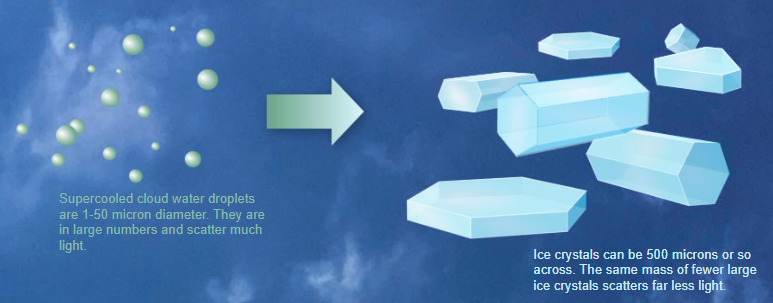Distrails - OPOD
Distrails: Understanding the Phenomenon
Have you ever looked up at the sky and noticed a peculiar dark trail in the clouds left behind by an aircraft? This fascinating atmospheric phenomenon is known as a distrail or dissipation trail. It occurs when an aircraft passes through high cirrus clouds, leaving a visible path in its wake. While the concept may seem simple, there are intriguing scientific factors at play that contribute to the formation of distrails.
The Science Behind Distrails
The formation of distrails is closely linked to the delicate balance between ice and supercooled water in the atmosphere. When an aircraft passes through sub-zero clouds, it causes tiny water droplets to evaporate and transform into larger ice crystals. These larger ice crystals scatter less light, creating the appearance of a gap or trail in the cloud.
The Stability of Water in Clouds
Below zero degrees Celsius, liquid water becomes unstable compared to solid ice. In cloud formations, however, the chance for water to freeze may not always be present. The absence of disturbances, well-separated water droplets, and a lack of dust or salt particles acting as nuclei can keep the cloud droplets in a supercooled state, meaning they remain as liquid despite being below freezing temperature.
The Role of Vapour Pressure
The key to understanding the transformation of water droplets into ice crystals lies in the concept of vapour pressure. Supercooled water has a higher vapour pressure than ice. If any ice crystals happen to form in a supercooled cloud, there is a rapid decrease in water vapour pressure, causing nearby droplets to evaporate. This evaporation process supplies more vapour for additional ice crystal formation, resulting in the replacement of water droplets with larger ice crystals within a short span of time.
Aircraft Disturbance and Crystallization Nuclei
An aircraft passing through the cloud can create the necessary disturbance to trigger the formation of distrails. The pressure waves generated by the aircraft, along with crystallization nuclei emitted from the engine exhausts, provide the ideal conditions for the transformation of water droplets into ice crystals. As a result, the aircraft leaves behind a visible dark trail or distrail in the cloud.
Hole-Punch Clouds and Trail Virga
While long trails are commonly associated with distrails, it's worth noting that holes can also form in the clouds, giving rise to what are known as "hole-punch" clouds. These clouds feature trail virga, which refers to ice crystals that fall from the holes formed in the cloud. This process of water droplet transformation into ice crystals, followed by melting into larger drops, is one of the ways in which rain forms—a phenomenon known as the Wegener-Bergeron-Findeisen process.
Conclusion
Distrails are a captivating atmospheric optics phenomenon that offer a glimpse into the intricate interactions between ice and supercooled water in the atmosphere. By understanding the delicate balance of vapour pressure and the role of aircraft disturbances, we can appreciate the formation of these intriguing dark trails left behind by passing aircraft. Next time you spot a distrail in the sky, take a moment to marvel at the complex science behind this mesmerizing phenomenon.

Distrails & Rain ~ The path of an aircraft in high cirrus is marked by a dark trail, a distrail or dissipation trail. Its formation is the result of subtle differences between ice and supercooled water. Images taken in Germany by Sebastian Luft. Images Sebastian Luft, shown with permission


Here an aircraft has caused tiny water droplets in sub-zero cloud to evaporate and produce the same mass of much larger ice crystals. The large crystals scatter less light and so give the appearance of a gap in the cloud.
Below zero Celsius liquid water is unstable compared to solid ice. Given the chance, the water undergoes a phase transition - it freezes. But, in cloud, the chance may not be there.
There is little disturbance, water drops are well separated and most importantly there may be few dust or salt particles to act as nuclei on which ice can start to crystallize. Instead, the cloud droplets remain liquid. They are supercooled - and metastable.
But supercooled water and ice cannot co-exist in equilibrium. If any ice happens to form there is a very fast change and all the water in that part of the cloud gets transformed to ice.
Vapour pressure is the key. Supercooled water has a greater vapour pressure than ice. If any ice is present there is a local drop in the pressure of water vapour. This causes droplets to evaporate. This supplies vapour for more ice formation and so on.. In a short time the water
droplets have evaporated and been replaced by a few much larger ice crystals.
An aircraft can produce the necessary disturbance via its pressure waves and supply crystallization nuclei from the engine exhausts.
Rather than long trails, holes can also form giving 'hole-punch' clouds from which trail virga of ice crystals.
This transformation of water droplets to ice crystals thence to snow which melts to large drops is one route by which rain forms - the Wegener- Bergeron-Findeisen process.

Note: this article has been automatically converted from the old site and may not appear as intended. You can find the original article here.
Reference Atmospheric Optics
If you use any of the definitions, information, or data presented on Atmospheric Optics, please copy the link or reference below to properly credit us as the reference source. Thank you!
-
<a href="https://atoptics.co.uk/blog/distrails-opod/">Distrails - OPOD</a>
-
"Distrails - OPOD". Atmospheric Optics. Accessed on November 26, 2024. https://atoptics.co.uk/blog/distrails-opod/.
-
"Distrails - OPOD". Atmospheric Optics, https://atoptics.co.uk/blog/distrails-opod/. Accessed 26 November, 2024
-
Distrails - OPOD. Atmospheric Optics. Retrieved from https://atoptics.co.uk/blog/distrails-opod/.